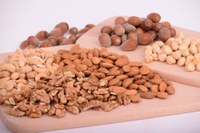Prairie Fare: Go nutty for nuts
(Click an image below to view a high-resolution image that can be downloaded)
I added a mixture of walnuts and dried fruit to a mixed green salad I was making in my home. I smiled as I thought about my changing eating habits.
As a kid, I would have eaten the salad greens and dried fruit, but nuts were off limits on my personal menu.
I was not allergic to nuts. I just did not like their taste. I did not appreciate their texture, either.
My mother added nuts to nearly every baked good, from brownies to cookies to quick breads. She probably knew they were good for us.
Guess what? I either ate around the nuts, picked them out or skipped the treats altogether. Eating around nuts in brownies is a little awkward.
I did like peanuts. However, peanuts are not really nuts. They are in the legume family, the same as beans.
I was missing some nutrition in my early nut-skipping days. Now, nuts are my go-to-snack. I now know a lot more about nutrition than I did as a child.
Nuts of all types provide fiber and protein in our diet. Just like all foods, nuts vary in the nutrition they contain.
Adding some nuts to your diet on a regular basis could reduce your risk of heart disease. Nuts contain fat, but the polyunsaturated and monounsaturated fats they contain are known to be heart healthy.
B vitamins and vitamin E found in nuts and other foods are linked to healthy skin, protecting against the aging process and promoting healthy skin.
Nuts also are a good source of minerals such as magnesium, copper, potassium and selenium. These minerals play important roles throughout our bodies in complex processes during the release of energy from all foods. Magnesium and potassium promote heart health.
Nuts also vary in their content of health-benefiting phenolic compounds. If you want to impress (or annoy) your friends, let them know that the almonds you are enjoying as a snack contain catechin, epicatechin and gallic acid.
Those are all health-benefiting natural chemicals in nuts. Yes, listing them might be annoying to your friends.
If you have nut allergies, do not start eating nuts because of their health-promoting symptoms. Other foods also provide these nutrients. People with any of the nine allergies currently noted on food labels should pay close attention to the statement starting with “contains” under the ingredient statement.
Try roasting chickpeas and add to salads and snacks for a non-allergenic crunch. See “Pinchin’ Pennies: Hummus, Roasted Chickpeas and More” from NDSU Extension.
People have asked me: “What’s the healthiest nut?” The healthiest nut is the type of nut you will eat, but remember moderation.
Scientists continue to study the nutrients in nuts and their relationship to health. Walnuts are particularly rich sources of antioxidant nutrients.
In one analysis, almonds were the top nut in fiber content, followed by pistachios and walnuts.
Remember that nuts tend to be fairly high in fat and calories. If you are trying to maintain your weight or lose a few pounds, be moderate in your consumption of nuts while treating your body to the potential health benefits.
One-fourth of a cup (about an ounce) of your favorite nut may help prevent you from a visit to the candy bar vending machine. That’s a small handful. An ounce of nuts would be 45 pistachios, 28 peanuts, 24 almonds or 14 walnut halves.
Aim for nuts that are unsalted or lightly salted, and measure them onto a plate. Enjoy their texture and taste. To get all the benefits of the various types of nuts, try mixed nuts.
Add a sprinkle of your favorite nuts to salads, cereal or baked goods such as muffins.
Here’s an easy recipe adapted from the Iowa State University’s “Spend Smart. Eat Smart.” collection of recipes. You can personalize with your favorite dried fruit or nuts or other add-ins.
Create Your Own Granola
2 cups oats (old fashioned or quick cooking)
1/2 cup mix-ins (dried fruit such as cranberries, nuts, sunflower seed kernels)
2 tablespoons oil (canola, sunflower or vegetable)
1/2 cup honey, maple syrup or pancake syrup
1/4 cup water
Preheat oven to 300 F. Spray a large baking sheet with nonstick cooking spray. In a large bowl stir together all ingredients. In a separate bowl, mix together the oil and honey or syrup, and stir until the oats are covered. Add the water into the oats and stir until absorbed by the oats. Spread the oat mixture across the baking sheet. Bake for about 45 minutes to 1 hour or until golden brown. Stir every 15 to 20 minutes. Cool completely on the baking sheet and store in an airtight container.
Makes nine servings (about 1/3 cup each). Each serving has 180 calories, 9 grams (g) fat, 3 g fiber, 29 g carbohydrate, 3 g fiber and 10 milligrams sodium.
(Julie Garden-Robinson, Ph.D., R.D., L.R.D., is a North Dakota State University Extension food and nutrition specialist and professor in the Department of Health, Nutrition and Exercise Sciences.)
NDSU Agriculture Communication – Feb. 22, 2024
Source: Julie Garden-Robinson, 701-231-7187, julie.garden-robinson@ndsu.edu
Editor: Elizabeth Cronin, 701-231-7006, elizabeth.cronin@ndsu.edu




